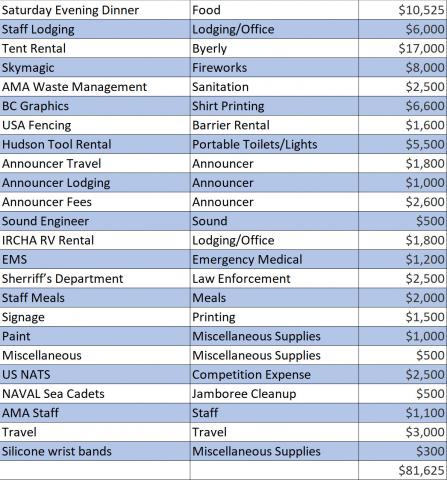Anatomy of a Large Event
We often get asked, what does it take to run an organization, and event like the IRCHA Jamboree. How much do things cost, how long do you prepare, how does it all get done.
Although the answers are simple, they are at the same time complex. Each year is different, and the planning committee has to project the estimated numbers of pilots, vendors and spectators. All items ordered ahead of time are based not only upon preregistration numbers, but industry trends, past experience and a little bit of educated guessing.
The event planning begins immediately after the event, with discussions about what worked well, what could be changed, and any ideas that came up during the event. Sometimes things work great and sometimes a little change can create a domino situation that leads to unforeseen benefits or problems.
The organization is something that does require a fair amount of time from its core group. The group meets typically monthly the first few months after the event ends, and then we progress to twice a month, and then weekly as we get close to the last few months before the event each year. On average we will have completed about 100 hours of meetings and discussions before we get to the event. This does not include the time at the Toledo Show, or the AMA Show, which we will attend to promote the hobby and perform helicopter seminars. All told, it is likely that we have put in 150 hours of meetings for event planning. This number does not include the individual time spent on maps, schedules, shirt design, phone meetings with companies/sponsors/AMA, etc. All told it is estimated that each member of the 4-person team volunteers approximately 16 days (384 hours) at the Jamboree and Trade Shows, along with 150 hours of personal time for additional organizational planning and helicopter promotion. This gives us a yearly total of 684 hours (28 days) of volunteer time to the organization for each member of the core group.
Lastly, how much do things cost? Well, this can also be relative. The years with the greatest numbers of pilots and vendors were also the most expensive years to run the event. We have had tent vendor bills as high as 28,000 during our biggest year. For now, the average over the last couple of years is pretty well estimated in the budget below.

As you can see from the event budget, we must deal with a large number of expenses and we work to keep costs controlled as much as possible. Our current vendor pricing has remained the same for over 7 years. We do this so that exhibitors and sponsors know what to expect each year, and they know that we will do everything possible to help them maximize their time at the event. We also work to keep pilot fees as low as possible, and are actually the lowest pilot’s fees of any large event in the USA. We work to maintain a positive relationship with pilots, sponsors, and companies so that everyone can have an incredible time.
The IRCHA organization is more than event. We work to promote RC Helicopters and represent the interest of RC helicopter pilots whenever possible. If you would like to help grow and develop our PIT Crew Progam/PIT Crew Training Days/Newsletter, etc., please contact us through the IRCHA website.
We hope this basic discussion of an “anatomy of a large event” gives you a better idea of what it really takes to run the IRCHA Jamboree.
